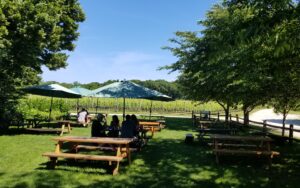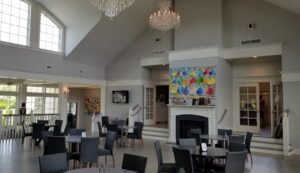For New York City residents and Long Islanders, a wine tasting trip to Long Island’s North Fork was and is the primary destination that didn’t require an extensive journey. The roads on the North Fork are a bit of well-groomed Americana; the vineyards are beautiful; and the people in the wineries are eager to demonstrate that Long Island belongs on the viticultural map. However, in the past the wines, to our taste, with few exceptions did not rise to the quality that the winemakers wished to credit them with.
We are pleased to report that a lot has changed in recent years, much for the better. There are more wineries, with more interest in improving the wine tasting experience and, again to our opinion, there are more wines worth a two-hour drive on the Long Island Expressway.
How have things changed, or not?
Tasting near the vines at McCall Wines.
Many of the experiences of wine tasting on Long Island have not changed. Once you get past Riverhead, there is village after village with wineries, either on Route 48 to the north or Route 25 to the south, with more on the latter road. The homes are gracious, huge trees overhang the roads (again more so to the south) and the wineries are well marked so that finding your way is simple.
But certain changes are more evident. Visitors don’t belly up to the bar and taste a broad selection of a winery’s offerings. In most cases, wines are available in preselected flights, or by the glass or bottle. Thus the atmosphere is a little more like being in a bar than a winery.
And even where there is a bar – some wineries don’t even have one! – most people take their tastes outdoors, on a patio, on a lawn or even right up next to the vines. This works spectacularly well on beautiful summer days (which we have been fortunate to experience) but might not be so enjoyable on a grey, muggy or rainy one.
The tasting room at Sparkling Pointe.
Another noticeable difference is that the food trucks are gone, at least on weekdays. Many of the wineries now offer food to pair with their wines. Mostly it’s cheese and charcuterie that are available, with some making more memorable repasts than others.
The pioneering wineries are still there and, based on some sampling, we can say that they are much as they were: not terrible but nothing to write home about either. But people with money have begun to open or take over wineries. They have invested in more architecturally pleasing tasting rooms and better winemaking equipment. With money, they can afford to invest in crafting better wines: dropping more fruit, hiring more workers to prune and care for the vines, and letting the grapes reach the fullest maturity.
The result has been a distinct heightening of the quality of the wines of the North Fork. To our tastes, Paumanok, McCall’s, Mattebella and Sparking Pointe lead the way. (Mattebella is reviewed in this issue. The others will be in focus in later editions.) We’re sure that others are coming to the fore as well.
In a few words, the North Fork has gone from being a pleasant diversion to a wine lover’s destination.

